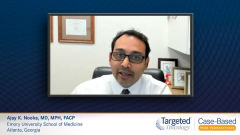
Importance of Depth of Response and Treatment Duration in NDMM
Considerations for assessing treatment response and electing to continue therapy in patients with newly diagnosed multiple myeloma.
Episodes in this series

Transcript:
Ajay K. Nooka, MD, MPH, FACP: In the clinical practice, forced induction responses are extremely important for us to have, but we are not using a response direct to treatment. One has to realize that not every patient’s response is exactly the same.
What we have done historically is give 4 cycles of induction treatment because that is where you get the best bang for the buck. You get the best response [with] the minimal toxicities. Can you give a fifth cycle? Absolutely. Yes, you can give a fifth cycle. But do you get the same kind of benefit as the first 4 cycles? The answer is probably not.
We’re taking more risk in terms of the toxicities, which accumulated by the end of the fifth cycle. So holding off after the fourth cycle, if the patient is achieved rather than a partial response, moving on [to] a transplant for consolidation is probably the best way…to minimize the side effects and maximize the benefit that you can get from these regimens.
I would ideally like a complete response from every patient, but if I get more than a partial response, I’m happy.
There’s a lot of evolving data on this exact same question of continuing to progression or giving the treatment for a prespecified time point. I’ll start the example with the IFM study. The IFM 2009 study is a randomized trial evaluating the timing of a transplant. All patients would receive the first 3 cycles of induction therapy with lenalidomide [Revlimid], bortezomib [Velcade], and dexamethasone—the classic RVd regimen.
And then patients would receive the stem cell collection, and patients would receive a transplant in the transplant arm, and [they] would receive [a] further 2 cycles of consolidation and patients would receive a final period of maintenance for 1 year.
In the nontransplant arm, patients would receive 3 cycles of RVd, collect the stem cells, [a] further 5 cycles of consolidation with RVd, and again, these patients would receive a total of 1 year of fixed duration of maintenance. What we are seeing is [that] patients who received a transplant earlier had a PFS [progression-free survival] benefit of close to a year.
What you saw was a PFS of 48 months for the transplant arm versus 36 months for the nontransplant arm before they progressed. So taking that data is meant again for patients who have received a fixed duration of maintenance.
Now, there is another trial which is evaluating the same exact question among patients receiving RVd in both arms and evaluating the timing of a transplant, but patients who receive the continuous maintenance until progression in the United States version of the same study, and this is the DETERMINATION study, which would be presented at ASCO [American Society of Clinical Oncology] annual meeting] 2022.
And these studies’ results are eagerly awaited by all of us. So, until then, what is the data that we have? In the United States, again, all the studies that were done in the maintenance have led onto continue the treatment until disease progression.
And we are seeing the benefit of these PFS to be beyond the 6- or 7-year mark, more likely favoring the continued maintenance, than if exploration of maintenance in favor of the PFS for the continued maintenance studies.
Transcript edited for clarity.









































